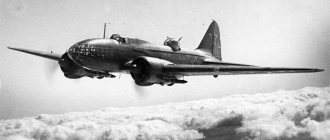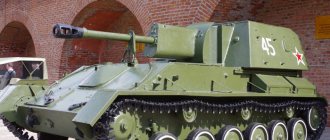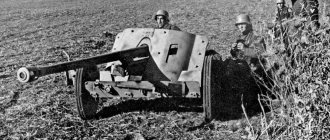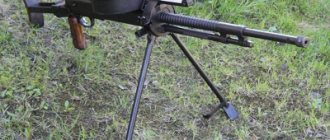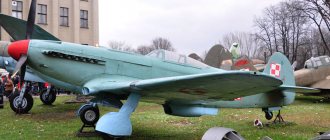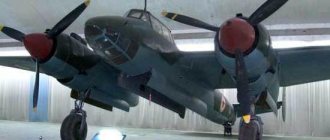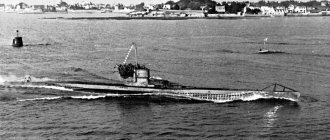By the end of the 30s, almost all participants in the coming world war had formed common directions in the development of small arms.
The range and accuracy of the attack was reduced, which was compensated by the greater density of fire. As a consequence of this, the beginning of mass rearmament of units with automatic small arms - submachine guns, machine guns, assault rifles. Accuracy of fire began to fade into the background, while the soldiers advancing in a chain began to be taught shooting on the move. With the advent of airborne troops, the need arose to create special lightweight weapons.
Maneuver warfare also affected machine guns: they became much lighter and more mobile. New types of small arms appeared (which was dictated, first of all, by the need to fight tanks) - rifle grenades, anti-tank rifles and RPGs with cumulative grenades.
Small arms of the USSR World War II
On the eve of the Great Patriotic War, the rifle division of the Red Army was a very formidable force - about 14.5 thousand people. The main type of small arms were rifles and carbines - 10,420 pieces. The share of submachine guns was insignificant - 1204. There were 166, 392 and 33 units of heavy, light and anti-aircraft machine guns, respectively.
The division had its own artillery of 144 guns and 66 mortars. The firepower was supplemented by 16 tanks, 13 armored vehicles and a solid fleet of auxiliary vehicles.
Rifles and carbines
Three-line Mosin
The main small arms of the USSR infantry units of the first period of the war was certainly the famous three-line rifle - the 7.62 mm S.I. Mosin rifle of the 1891 model, modernized in 1930. Its advantages are well known - strength, reliability, ease of maintenance, combined with good ballistics qualities, in particular, with an aiming range of 2 km.
Mosin Three-Ruler
The Three-Ruler is an ideal weapon for newly recruited soldiers, and the simplicity of the design created enormous opportunities for its mass production. But like any weapon, the three-line gun had its drawbacks. The permanently attached bayonet in combination with a long barrel (1670 mm) created inconvenience when moving, especially in wooded areas. The bolt handle caused serious complaints when reloading.
After battle
On its basis, a sniper rifle and a series of carbines of the 1938 and 1944 models were created. Fate gave the three-line a long life (the last three-line was released in 1965), participation in many wars and an astronomical “circulation” of 37 million copies.
Sniper with a Mosin rifle (with a PE optical sight, model 1931)
SVT-40
At the end of the 30s, the outstanding Soviet weapons designer F.V. Tokarev developed a 10-round self-loading rifle cal. 7.62 mm SVT-38, which after modernization received the name SVT-40. It “lost weight” by 600 g and became shorter due to the introduction of thinner wooden parts, additional holes in the casing and a decrease in the length of the bayonet. A little later, a sniper rifle appeared at its base. Automatic firing was ensured by the removal of powder gases. The ammunition was placed in a box-shaped, detachable magazine.
The target range of the SVT-40 is up to 1 km. The SVT-40 served with honor on the fronts of the Great Patriotic War. It was also appreciated by our opponents. Historical fact: having captured rich trophies at the beginning of the war, among which there were many SVT-40s, the German army... adopted it for service, and the Finns created their own rifle on the basis of the SVT-40 - TaRaKo.
Soviet sniper with SVT-40
The creative development of the ideas implemented in the SVT-40 became the AVT-40 automatic rifle. It differed from its predecessor in its ability to fire automatically at a rate of up to 25 rounds per minute. The disadvantage of the AVT-40 is its low accuracy of fire, strong unmasking flame and loud sound at the moment of firing. Subsequently, as automatic weapons entered the military en masse, they were removed from service.
Submachine guns
PPD-40
The Great Patriotic War was the time of the final transition from rifles to automatic weapons. The Red Army began to fight, armed with a small number of PPD-40 - a submachine gun designed by the outstanding Soviet designer Vasily Alekseevich Degtyarev. At that time, PPD-40 was in no way inferior to its domestic and foreign counterparts.
Designed for a pistol cartridge cal. 7.62 x 25 mm, the PPD-40 had an impressive ammunition load of 71 rounds, housed in a drum-type magazine. Weighing about 4 kg, it fired at a rate of 800 rounds per minute with an effective range of up to 200 meters. However, just a few months after the start of the war, it was replaced by the legendary PPSh-41 cal. 7.62 x 25 mm.
PPSh-41
The creator of the PPSh-41, designer Georgy Semenovich Shpagin, was faced with the task of developing an extremely easy-to-use, reliable, technologically advanced, cheap to produce mass weapon.
PPSh-41
Fighter with PPSh-41
From its predecessor, the PPD-40, the PPSh inherited a drum magazine with 71 rounds. A little later, a simpler and more reliable sector horn magazine with 35 rounds was developed for it. The weight of the equipped machine guns (both versions) was 5.3 and 4.15 kg, respectively. The rate of fire of the PPSh-41 reached 900 rounds per minute with an aiming range of up to 300 meters and the ability to fire single shots.
PPSh-41 assembly shop
To master the PPSh-41, a few lessons were enough. It could easily be disassembled into 5 parts made using stamping and welding technology, thanks to which during the war years the Soviet defense industry produced about 5.5 million machine guns.
PPS-42
In the summer of 1942, the young designer Alexey Sudaev presented his brainchild - a 7.62 mm submachine gun. It was strikingly different from its “bigger brothers” PPD and PPSh-41 in its rational layout, higher manufacturability and ease of manufacturing parts using arc welding.
PPS-42
Son of the regiment with a Sudaev machine gun
PPS-42 was 3.5 kg lighter and required three times less manufacturing time. However, despite its quite obvious advantages, it never became a mass-produced weapon, leaving the PPSh-41 to take the lead.
DP-27 light machine gun
By the beginning of the war, the DP-27 light machine gun (Degtyarev infantry, 7.62mm caliber) had been in service with the Red Army for almost 15 years, having the status of the main light machine gun of infantry units. Its automation was powered by the energy of powder gases. The gas regulator reliably protected the mechanism from contamination and high temperatures.
The DP-27 could only fire automatically, but even a beginner needed a few days to master shooting in short bursts of 3-5 shots. Ammunition of 47 rounds was placed in a disk magazine with a bullet towards the center in one row. The magazine itself was mounted on top of the receiver. The weight of the unloaded machine gun was 8.5 kg. An equipped magazine increased it by almost another 3 kg.
Machine gun crew DP-27 in battle
It was a powerful weapon with an effective range of 1.5 km and a combat rate of fire of up to 150 rounds per minute. In the firing position, the machine gun rested on a bipod. A flame arrester was screwed onto the end of the barrel, significantly reducing its unmasking effect. The DP-27 was serviced by a gunner and his assistant. In total, about 800 thousand machine guns were produced.
Through the eyes of front-line soldiers: snipers of the Great Patriotic War
Not only the quality of the weapon, but also the ability to use it plays an important role in the outcome of the battle, so a survey was conducted among front-line soldiers about sniper work. We tell you what shortcomings were most often pointed out by Red Army soldiers
Nowadays on the Internet you can find different opinions about the capabilities of wartime sniper rifles. Sometimes they are even expressed by people who own authentic rifles and scopes.
However, their results, although quite real, should be treated “with an allowance.”
Firstly, we must take into account that not all sights and rifles have survived to this day. As is the case, for example, with the famous Japanese swords, which we judge by the works of the best craftsmen, and not by the much more unprepossessing instruments of military labor of ordinary samurai, the best examples were sent for storage after the war.
Secondly, the capabilities of a sniper weapon especially depend not only on its technical characteristics, but also on the shooter’s ability to use them.
This was well understood by the officers of the Red Army General Staff who conducted surveys of front-line soldiers. In particular, at the end of 1944, the questionnaire “The use of snipers in combat based on the experience of the Patriotic War” included 36 questions concerning not only the weapons of snipers, but also the ability to use these weapons.
One of the most important was the issue of determining the distance to the target.
“The best way to determine the distance to a target is to use a scope or binoculars to determine the distance. But most snipers determine the distance by eye and make an error of 19 to 15%.”
“The distance is determined mainly by eye and in rare cases by the angular values of local objects, and an error of 5-8% is allowed.”
“With fairly frequent training, errors were made by 5-7% of the distance. Good snipers, without training for 15-20 days, made errors of up to 10-15% of the distance, especially on hilly terrain.”
“The distance was determined mainly by the eye. The error did not exceed 1/10-1/12 of the distance.”
“Errors are made on sections of terrain up to 20%, through optics from 8% to 12%.”
The next set of questions concerned how snipers are able to take into account various external factors when shooting.
“The extent to which snipers are able to use point-blank range has not been studied. Snipers have little understanding of the issues of derivation and the influence of side winds.”
“Snipers choose their aiming point taking into account the combat of their rifle and weather conditions. When shooting at clearly visible targets, set the sight according to the distance and, if necessary, raise the aiming point by 0.5-1 target, because Most snipers do not know how to use the table of trajectory elevation above the line of sight.”
“Derivation, lateral deflection of a bullet in a crosswind, changes in external conditions (temperature, pressure, altitude) are taken into account and determined by shooting with tracer bullets; theoretical calculations are not carried out.”
“In practice, snipers fire up to 600 m. Fire is rarely fired beyond this distance, primarily due to the uncertainty of being hit with one shot. Three main factors are at play here: poor shooting training of snipers at these distances and some fear of detection by enemy snipers located on the front line; the selected position does not allow viewing the enemy’s location at a distance of up to 800 meters.”
“Only experienced snipers take into account derivation when shooting at distances over 500 meters by appropriately moving the aiming point.
…
Almost none of the snipers take into account deviations of external shooting conditions from normal (temperature, pressure, altitude, longitudinal wind) and, as a result, do not hit targets at long distances.”
“All this is achieved through the personal experience of each sniper, because the theory of this branch of ballistics, as a rule, is poorly mastered by snipers.
Due to insufficient theoretical training of snipers, the influence of external conditions on shooting accuracy (temperature, pressure) is almost not taken into account by them. To a certain extent, the height of the targets and the longitudinal wind are taken into account, as factors that are most easily determined by external signs.
When shooting from a distance, when it is necessary to take into account external conditions (side wind, etc.), snipers rarely hit the target with the first shot. More often - from the second shot, and precisely from the second, since the third shot (and every sniper knows this from experience) is almost impossible for the sniper to fire due to the disappearance of the target.”
“Theoretically, snipers know how to take into account external conditions that affect the normality of shooting, but in practice they take into account the shots.”
“Experienced snipers, before going into an ambush, check the distance to targets by firing tracer bullets or armor-piercing incendiary bullets, which give off a flash when they hit a solid object.”
“A well-trained sniper hits the target with the first shot and at a distance at which external conditions, crosswinds and diversion are supposed to be taken into account. Other snipers don’t shoot at such distances.”
“The sniper takes into account the derivation and side wind after firing a sighting cartridge and then makes adjustments.
In practice, the sniper does not take into account deviations of external shooting conditions from normal (temperature, pressure, longitudinal wind, etc.).
A sniper can hit a target with the first shot, without taking into account external conditions (side wind and diversion). In most cases, snipers will practically not fire up to 600 meters, which gives a greater probability of defeat.”
“Experienced snipers hit the target with the first shot, taking into account the external conditions affecting the bullet’s flight, at a distance of up to 500 meters.”
In the block of questions concerning the rifle and scope itself, in addition to collecting information about the current state of affairs, the opinion of snipers was also studied regarding the need to introduce additional divisions on the scope and the so-called “double trigger” (with a warning).
“The reviews from snipers about the rifle are good.
There is no need to enter the half divisions of the sight. Most snipers are against the introduction of a double trigger, but favor a short and smooth descent.
Snipers note the following disadvantages of the optical sight:
a) lack of stable mounting of the sight on the rifle, which entails inaccurate combat,
b) the absence of a light filter on the sight lens, which makes shooting at sunset or sunrise difficult,
c) there are cases of lenses fogging from the inside, especially when the temperature changes, and cases of unscrewing the corkscrew screw of the optical sight due to vibration when shooting. It is advisable to bring the optical sight a little closer to the shooter's eye.
Snipers prefer the PU-44″ optical sight.
“Practice shows that it is better to have a double trigger on a sniper rifle. When it comes to scopes, some suggest adding half graduations to the scope, while some favor full graduations. Snipers consider the PU scope to be the best scope.”
“All the qualities of the rifle are positive, but sometimes there is a tight trigger, a poor-quality optical sight, and a double trigger will make the sniper’s job easier. The sight is better than the PU.”
“The sniper rifle is heavy in weight and has no uniformity in the trigger. It is advisable to have a soft and short descent. It is necessary to have a half division.
The optical sight is mounted well on the rifle, but very high above the axis of the bore and when shooting you have to tear yourself away from the butt. There are cases of optical disturbances during shooting, and sight settings are lost. It is necessary to make a fuse-corolla over the front glass (lens) from sunlight and rain.
Snipers prefer the PU sight, but its visibility at dawn and dusk is insufficient. The field of view needs to be increased."
“Snipers prefer the PU sight, but it is advisable to increase it by another factor of two (i.e., instead of 4, by 6 times).”
“There have been a number of cases where, after 5-6 shots, the optical sight goes astray and new verification is required. As a rule, this is due to poor quality factory work.
…
Why have safety caps not been introduced for shooting in clear weather and in rain? Some people want to have a filter.”
“The upgraded sniper rifle is suitable for its weight, but the sights need to be rifled at 50 meters and have a double trigger.”
“It is advisable to have a device (silencer) for producing a silent shot. There is a lack of relevant literature."
“Snipers prefer PU optics, which are more economical, since they weigh less. PU and PE do not get close enough and it is desirable to double the visibility and approach.”
“Feedback on a sniper rifle: a) the weight does not satisfy the sniper during long-term work, and also the length; b) snipers do not know the value of half... c) it is more advisable to have a single, smooth trigger, because a double trigger tires the sniper.”
Some reports also drew attention to the quality of the cartridges:
“It is advisable to have cartridges of the 1930 model, from the same batch (packaging) and from one that can be improved,” they found. Unfortunately, the sniper movement in the Red Army, although massive, was not systematically prepared enough - primarily in matters of training. The presence of experienced snipers in the unit, who could pass on at least some of their skills to the young shooters, greatly helped matters. But this did not always happen and not everywhere.
“The issues of sniper work are dealt with extremely insufficiently from top to bottom, often in periods of influx. If units go on the offensive (even with fewer personnel), snipers go into battle as shooters.”
“Experience has shown that snipers need to be removed from units, since they, as a rule, are used not for their intended purpose (as observers, messengers, etc.), but in offensive battles - as ordinary shooters, which leads to a quick and unreasonable loss of snipers "
Unfortunately, after the war, the view prevailed in the Soviet army that in the conditions of a future global nuclear missile conflict, snipers would no longer play their previous role on the battlefield. Developed by M.E. Dragunov in the late 50s, the SVD rifle was an excellent weapon, but intended for “sharp marksmen” - “Marxmen” according to the Western classification. The experience of sniper work accumulated during the Great Patriotic War remained largely unclaimed. As a result, a lot had to be recreated in the late 90s - early 2000s virtually from scratch.
Small arms of the Wehrmacht of World War II
The main strategy of the German army is offensive or blitzkrieg (blitzkrieg - lightning war). The decisive role in it was assigned to large tank formations, carrying out deep breakthroughs of the enemy’s defenses in cooperation with artillery and aviation.
Tank units bypassed powerful fortified areas, destroying control centers and rear communications, without which the enemy quickly lost their combat effectiveness. The defeat was completed by motorized units of the ground forces.
Small arms of the Wehrmacht infantry division
The staff of the German infantry division of the 1940 model assumed the presence of 12,609 rifles and carbines, 312 submachine guns (machine guns), light and heavy machine guns - 425 and 110 pieces, respectively, 90 anti-tank rifles and 3,600 pistols.
The Wehrmacht's small arms generally met the high wartime requirements. It was reliable, trouble-free, simple, easy to manufacture and maintain, which contributed to its serial production.
Rifles, carbines, machine guns
Mauser 98K
The Mauser 98K is an improved version of the Mauser 98 rifle, developed at the end of the 19th century by the brothers Paul and Wilhelm Mauser, founders of the world famous arms company. Equipping the German army with it began in 1935.
Mauser 98K
The weapon was loaded with a clip of five 7.92 mm cartridges. A trained soldier could shoot 15 times within a minute at a range of up to 1.5 km. The Mauser 98K was very compact. Its main characteristics: weight, length, barrel length - 4.1 kg x 1250 x 740 mm. The indisputable advantages of the rifle are evidenced by numerous conflicts involving it, longevity and a truly sky-high “circulation” - more than 15 million units.
At the shooting range. Mauser 98K rifle
G-41 rifle
The self-loading ten-shot rifle G-41 became the German response to the massive equipping of the Red Army with rifles - SVT-38, 40 and ABC-36. Its sighting range reached 1200 meters. Only single shooting was allowed. Its significant disadvantages - significant weight, low reliability and increased vulnerability to contamination - were subsequently eliminated. The combat “circulation” amounted to several hundred thousand rifle samples.
G-41 rifle
MP-40 "Schmeisser" assault rifle
Perhaps the most famous Wehrmacht small arms of the Second World War was the famous MP-40 submachine gun, a modification of its predecessor, the MP-36, created by Heinrich Vollmer. However, as fate would have it, he is better known under the name “Schmeisser”, obtained thanks to the stamp on the store - “PATENT SCHMEISSER”. The stigma simply meant that, in addition to G. Vollmer, Hugo Schmeisser also participated in the creation of the MP-40, but only as the creator of the store.
MP-40 "Schmeisser" assault rifle
Initially, the MP-40 was intended to arm the command staff of infantry units, but later it was transferred to the disposal of tank crews, armored vehicle drivers, paratroopers and special forces soldiers.
A German soldier fires from an MP-40
However, the MP-40 was absolutely unsuitable for infantry units, since it was exclusively a melee weapon. In a fierce battle in open terrain, having a weapon with a firing range of 70 to 150 meters meant for a German soldier to be practically unarmed in front of his enemy, armed with Mosin and Tokarev rifles with a firing range of 400 to 800 meters.


